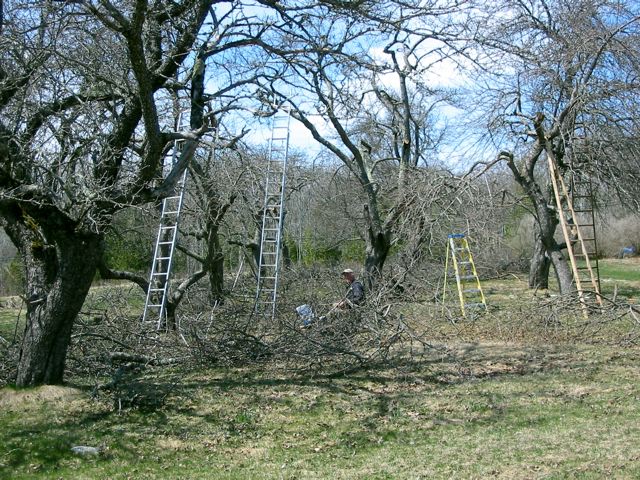Author: elizapples
The Holy Grail of Apple Nerdery is Here…
When I apprenticed for John Bunker in Maine, one of my paid gigs was to help create an online apple key. All summer and fall, I entered apple descriptions into the computer from a gigantic three ring binder containing 16,000+ apple varieties. That three ring binder was Dan Bussey’s book, version 1 of The Illustrated History of Apples in the United States and Canada….in size 5 font with no pictures. I didn’t even make it out of the B’s that year.
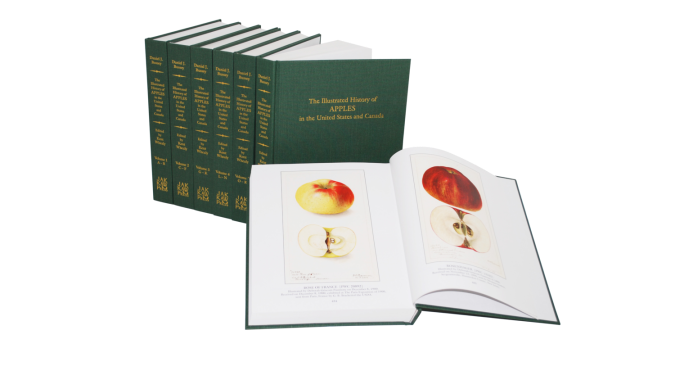
7 years later, the day has come for this 7 VOLUME SET to now be available for purchase and hugging. This, friends, is truly the holy grail of apple nerdery. And it’s affordable at $350 (which includes shipping). Don’t believe me? Try buying an original copy of Apples of New York Volumes 1 and 2. (and you only get 2 volumes compared with 7)
I just bought a set and thought I’d share it on this blog because I’m excited about it and want Dan to sell thousands of volumes. With the exception of William Cox’s A View of the Cultivation of Fruit Trees (which I’ll probably never own a real copy of), I’m fairly certain my heirloom apple library is now complete with this acquisition.
Wondering what to get that special someone in your life who enjoys apples? Why not get them the most overwhelming 7 volume set of apples you possibly can this year. The pictures alone are worth the $350.
Dwarfing Mulberries: An Afternoon with Dr. A.J. Bullard
“Over here are the mulberries. This one is a pure Morus rubra that produces 2 inch fruits.” “Liza. Can you tell me what is different about this tree?”
This is the way of Dr. A.J. Bullard. He playfully taunts you with little snippets from his 70+ years of tree knowledge and then immediately follows it up by asking you seemingly impossible questions. “What is different about this tree?”
Dr. A.J. Bullard isn’t a former horticultural professor, but a former baseball player and Dentist who is a botanical wiz. He reads botanical textbooks and then writes letters consisting of page upon page of single spaced revisions and fact checking to the authors. The most common complaint he voiced to me in reading these texts was how everyone seems to copy information from book to book rather than doing the research for themselves. Dr. Bullard is that man, the guy who has studied the intricacies of the Southeastern plant world so thoroughly and in real life that he often receives identification questions which have stumped the arboretums and universities (and he figures them out).
I didn’t know this about A.J when I went to visit him. I knew of him as the former president of the North American Fruit Explorers (NAFEX) who probably knows more about mulberries than anyone in the US. His knowledge is integral to the advancement of mulberries as a tree crop in the United States.
This blog post/essay is in relation to a running conversation about mulberries that I’ve had with A.J ever since we met (my boyfriend would tell you that I talk to A.J on the phone more than I talked to him when we first started dating). The full conversation will be in the form of a presentation at this year’s annual NAFEX/NNGA conference in Tifton, Georgia. Among the multitudes of reasons why you should be there, hearing A.J. talk is one very, very good reason.
“What is different about this tree?”

Slowly, we approached the above pictured mulberry tree and he asks us again: “What is different about this mulberry tree?” I think on it for a bit and come up with nothing, so he asks again. “What do you see that is different with this tree?” I got nothing, A.J. No idea. “What about the height? It’s no taller than 12 feet,” he says. Ah, right…mulberries aren’t normally 12 feet tall unless they are a naturally dwarfing cultivar. “Correct!” “What if I told you this wasn’t a dwarf cultivar? What if I told you that I have figured out how to dwarf mulberries?”
Dear readers- Have you ever had your mind blown? It’s a flooding of immense realization and wonder and excitement, all at the same time. What I’m about to tell you not only blew my mind, but in a strange way paralleled my own exploits.
Dwarfing trees is a huge deal these days. Thousands and thousands of orchard acres are getting converted yearly into dwarfing orchards because 1.) more trees per acre=more fruit per acre 2.) smaller trees are easier and cheaper to manage/harvest. If you pick up an fruit industry magazine, there’s usually a very good chance of the magazine featuring one article on the promise of better dwarfing rootstock for pears/cherries/peaches/name fruit tree in the coming years because that’s where the industry is headed. However, there are some downsides to all of this and it’s usually in these three sectors: Costs (because trellis systems or support posts are expensive, Longevity (dwarfing rootstocks are shorter lived, maybe 25 years), and Input (these trees require tending from humans or else they’ll suffer and/or die).
What A.J has done to get dwarfing mulberries would allow an orchardist to fit close to 200 mulberry trees per acre. It costs less than, say, planting the same number of apple trees per acre on an m26 rootstock (semi-dwarfing) because the trees you plant are able to stand up without the need for support posts. They are longer lived (the trees pictured are 40 years old). And there are no chemical or water inputs necessary (other than establishment necessities).
Mulberry trees are naturally tall for fruit trees, usually around 30 feet or more (for M.alba and M.alba x M.rubra hybrids). Given the standard size, if you were to prune heavily every year, you could probably fit 70 trees per acre (more like 40 trees per acre if you didn’t prune heavily). With Dr. Bullard’s dwarfing methods, you could likely plant 3-5 times that amount per acre. Which, just to throw it out there, would be an incredible set up not only for people wanting to sell mulberries, but also for pastured chicken or pastured pork operations (more about that later).
Alright, so what goes into Bullard’s dwarfing methods? Note: What I’m about to discuss is only an hypothesis. We don’t know what is actually going on, but this is our best guess. Well, we think the name of the game is incompatibility. If you study the history of apple rootstocks like I have, it’s only a matter of time until you start to come across accounts of rootstocks (aka, the roots to which you graft your cultivar/scion/variety) imparting various characteristics into the cultivar/variety (here’s a fun essay on the subject I wrote last December). Some characteristics include a change in flavor, tree size, fruit size, disease resistance, yields, and death, among other things. Some of these characteristics (like death) are deemed incompatibilities. Keep this in mind.
Alright, so what did A.J do?
He took Morus alba (white mulberry- brought over from Russia in the 1600’s for silk production) and to it, he grafted Morus rubra (red mulberry-our native mulberry) or a rubra x alba hybrid. He planted the grafted trees in pots and let the rubra send out a vigorous shoot. Then he tightly wrapped a copper wire just above the graft union and buried the whole tree, leaving a small amount above ground. What grew up from there became a dwarf mulberry tree. Across the boards. At one point in time, he had an orchard of around 150 cultivars and he employed this method to fit them all into his yard. If you look at the above picture, you’ll see other dwarfed mulberry trees- all different cultivars.
He put the trees on their own roots using a method very similar to the one I made up 2 years ago (which you can read about in this essay). That’s part of the reason why my mind was blown, because I’ve been down this rabbit hole before with apples; only with A.J I got a chance to see a glimpse of what the future could possibly look like for my experiments. And also, there are major agricultural implications for this (a later essay).
Why does it work? We’re not totally sure, but we both think it could be some form of incompatibility transferred from the M. alba into the M.rubra which imbedded itself into the scion/variety/cultivar by the time the rootstock/nurse root girdled off and the tree was on it’s own roots. That incompatibility caused dwarfing. If you look at the ground where tree hits soil, you’ll see a bulge. Perhaps that’s where the vigor went.
Anyways- this is all very exciting and details of all of this, including how exactly to do it (which I’m doing as we speak) will happen this year at the NAFEX annual meeting in Tifton, Georgia.
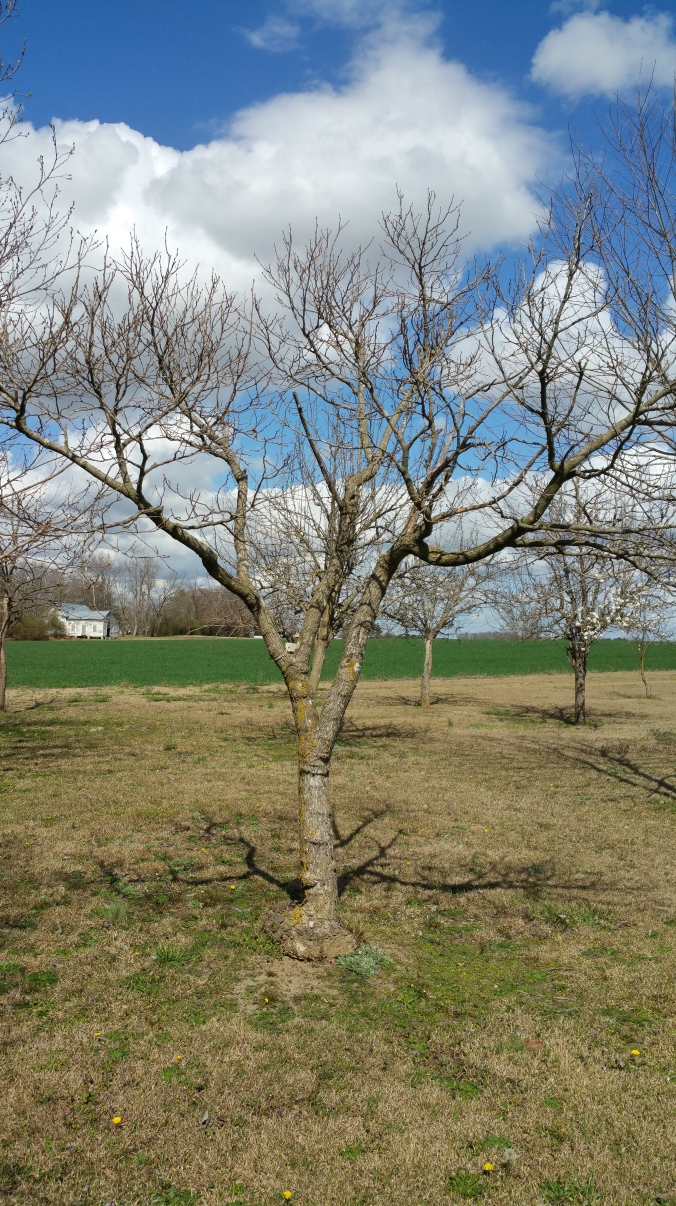
I’m Hosting a FREE Workshop on How to Become a Guerrilla Grafter (aka, topworking)
Hi folks!
Do you want to learn how to take one of those invasive bradford pear trees the landscaper planted along your driveway and turn it into an Asian or European pear tree? How about turning your red delicious tree that you accidentally planted from Home Depot into a vibrant heirloom cultivar? Or change over a native persimmon tree seedling, or a Chinese chestnut, or a black walnut, or… you name it, really. Want to learn these skills for free in exchange for a few hours of sweat equity and camaraderie? Do I have the opportunity for youuuu!
APRIL 1st and 2nd (12:30-5ish) in Jefferson Maryland!!! Yes, I know that’s only 2 weeks away, but I was worried that my window for doing this wouldn’t be viable over those dates due to February’s summer temperatures. Fret not, we have plenty of time. Come one, come all… learn the skills necessary to become true guerrilla grafters.
The PROJECT: I will be hosting a Guerrilla Grafting party in order to convert as many bradford pears on our farm over to asian pears as possible within a 2 day period. Here’s a map for most of the trees:
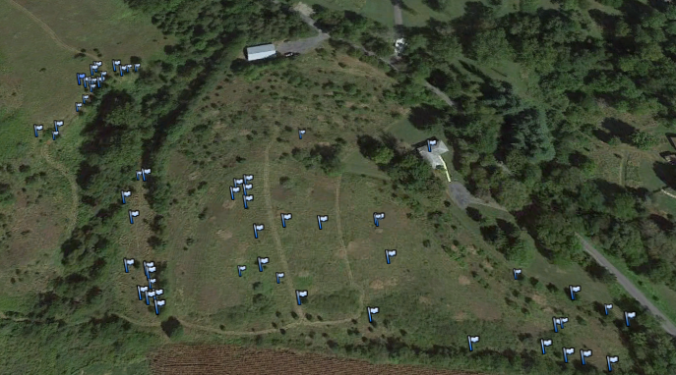
What will this event look like?
1.) You show up with friends, a grafting knife, a finer-toothed (pruning) saw, and clothes that can get some paint on them. A step ladder and hammer would also be good if you can bring them.
2.) I give you quality instruction and inspiration for guerrilla grafting. Then I pair you up and send you to a bradford pear sector to get your graft on.
3.) You leave with the skills and confidence necessary to guerrilla graft!
4.) A special bonus for helping- In 2018, I’ll supply you with moderate amounts of asian pear scionwood ($3.50/foot street value) to go off into the wild/suburbs/urban areas and turn bradford pears into asian pears.
INTERESTED? If so- fill out this google form.
Need a knife? Indicate on the google form (or email me) AND PAY for the knife via paypal on this blog and I’ll get you one for $15 bucks.
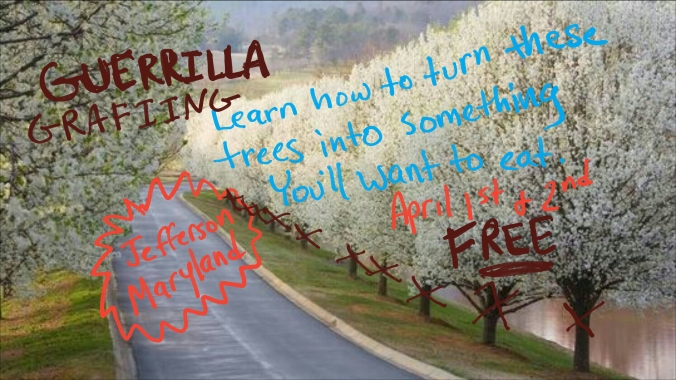
The Ecosystem Orchard: A New Orchard Aesthetic
Excellent blog post by fellow apple grower Mike Biltonen of Know Your Roots!
For well over 100 years, orchardists and researchers alike have been striving for ways to make orchards more productive, efficient, and profitable. And while the story doesn’t begin with England’s East Malling and Long Ashton (EMLA) Research Stations, the modern chapters of dwarf fruit tree production certainly do. The East Malling research station was established in 1913 as a way to “study the problems which are met with in the actual culture of fruit trees and bushes.” Though not limited to development of dwarf rootstocks, its establishment launched the orchard world down a path that has resulted in smaller and smaller trees, planted in increasingly higher densities, requiring greater inputs of resources, pesticides, and money. And there is no doubt these technological advancements have led to greater productivity, cosmetic fruit quality, and profitability. But at the same time they’ve gutted the heart and soul from fruit orchards, reducing overall biodiversity…
View original post 703 more words
WOMEN NEEDED for March 4th & 5th Grafting Workshops- UPDATE to the UPDATE
THE MARCH 4TH AND 5TH CLASSES ARE FULL!!! HOWEVER….
The classes are man-heavy and I’d like to see more of a gender balance in these workshops. I’ve decided to enlarge each of these classes (March 4th and 5th) by 6 participants and those spots are only for women (or those who identify as women). What would it take to get you to this workshop (or future workshops), ladies? Whatever it will take to get you here, I want to know. Please fill out this form!
Say you bought an apple tree at Home Depot. It was a red delicious and you got one hell of a deal (maybe $10 dollars or so). You’re excited because the tree is cheap and soon you’ll have arm-fulls of apples from you own backyard.
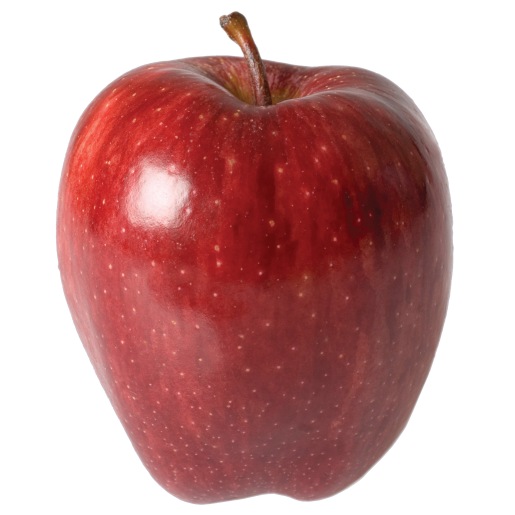
Well, this is all well and good until you taste these apples and find out what an awful mistake you made. Especially when you sneak over to your neighbor’s yard and try one of the apples off of their trees. You ask them what it is and they’ve forgotten, so you’re sad that you’ll never be able to buy another tree like it. You can either cry as you’re eating your gross red delicious apples, or rejoice because there is hope for you yet!
!!! I CAN TEACH YOU HOW TO TAKE A CUTTING OFF OF YOUR FAVORITE TREE AND MAKE YOUR OWN TREE FOR WAY LESS THAN WHAT HOME DEPOT CHARGES!!!
That’s basically what this workshop is all about. Sign up and I’ll not only teach you the nuts and bolts of grafting an apple tree for far less than $10, but you’ll go home with 2 trees.
With the skills I’m going to teach you, you will be able capture the fruit or ornamental qualities of whatever trees you desire and bring them to your own backyard or orchard. You’ve found a tree without any disease that tastes great? No problem! You will soon be able to propagate it. Whoa, look at that bloom! With my guidance you’ll know what to do in order to capture it…
Grafting is seriously one of the most empowering tools you can learn. I mean, it’s basically combining the thrill of creating a Frankenstein with the utility of being able to eat whatever fruit you damn well please from your backyard.
The cost of this workshop? $40 dollars.
What you’ll take home? A lifelong skill which will enable you to capture all the flavors you desire. Also you get 2 trees.
Where will it be held? Jefferson, MD
When will it be held? March 4th (sold out), March 5th from 1 to 4
And who will be leading it? Yours truly, Eliza A. Greenman. Monikers include: Elizapples or the Apple Queen (of Kyrgyzstan).
Sign up now! Spaces are limited!
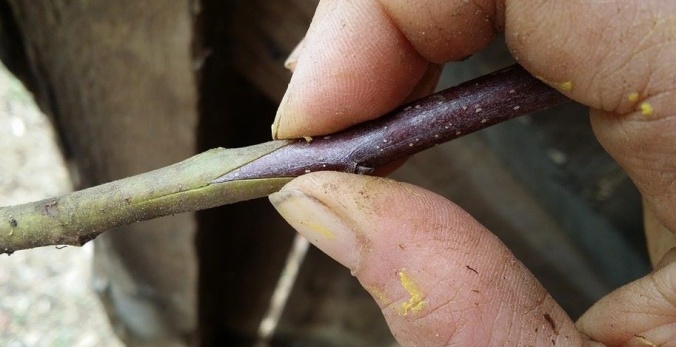
Old Orchard Restoration/Pruning 101 Workshop (note: it has been rescheduled for Jan 7th and 8th)

January 7th & 8th, 2017: Apple Pruning 101 and Abandoned/Old Tree Restoration
*Notice! I have had to change the dates of this workshop due to agreeing to speak at the Horticultural Industries Show Conference in Arkansas. Sorry for the inconvenience!*
Location: Lovettsville, VA and Surrounding Areas
Click HERE to sign up!
This is a 2-day hands-on pruning intensive course which will cover everything you need to tackle an apple tree, young or old…kept or abandoned. Day 1 will cover the basics of pruning, from tree physiology to how to make a pruning cut to the considerations that go into making a cut. We’ll cover all sizes of apple trees from just planted to deer browsed to juvenile to mature trees. The day will end with participants breaking into supervised groups and working on trees. Day 2 will put into action all that we learned the day before, only this time we mean business. We’ll cover how to prune the big, burly, and the old. We’ll also cover top-working (changing a tree over to another variety) and the steps needing to be taken in order to graft a tree over to a new variety in spring. This class will be capped at 20 participants. Cost Per Person: 2 day workshop is $110, 1 day is $70. Overnight lodging can be made available, ask for more details. In addition to money, work trade and barter are both acceptable means of payment. CLICK HERE TO SIGN UP!
Rootstocks: Do they impact flavor?
Earlier this year, as I was doing some research on the effects of grafting apple varieties to Malus angustifolia (southern crabapple), I kept running across interesting accounts of noticeable changes to the apple varieties when grafted to crabapples. One of these changes is in flavor, which is what I’m writing about today.
This is the original snippet that sparked my interest. Why? Because this dude back in the 1800s is telling me that when he took the Bethlehemite apple, a dessert/culinary apple from Ohio, and grafted it to a crabapple rootstock, he got something different from the original variety. The grafted Bethlehemite apple had developed some astringency. Astringency is the key word here.
OMG, DID THIS GUY TURN A DESSERT APPLE INTO A CIDER APPLE BY GRAFTING IT ONTO A CRAB ROOTSTOCK?
This thought has rumbled around in my head for the better part of this year and whenever I had a moment to sit at the computer and not read my emails, I researched this topic a bit more. First, I went back in history (via google books) to find more testimonials of these findings. Here are a few:
1867:
1889:
I could go on, but there are many, many testimonials in favor of rootstock having a flavorful impact on the grafted variety. There were some naysayers, who basically just said “this can’t be so” and changed the subject. But all in all, my historical research has been in favor of a rootstock’s ability to change flavor in apple varieties.
Eager to pursue this topic, I started looking up scientific papers on the subject and started with this, Cornell’s research on nutrient uptake by different rootstocks. The thoughts and questions of the horticulturalists back in the 1800s seem to still align with the questions of today, as seen in this conclusion:

“The ability to match the nutritional requirements of a scion cultivar to a specially tuned rootstock…” COULD, in my opinion, create a cider apple out of a friggin’ dessert fruit.
Positive, I kept up the research and found considerable evidence in citrus fruit that rootstocks can change the flavor of the fruit. Here. Here. And Here.
This study, which looked at an apple rootstock’s impact on triterpene (cancer and immune disease prevention chemical compounds) found this:
“The largest differences in triterpene content were found between rootstocks. The results showed that both at harvest time, and after cold storage except the first harvest time samples, the apples from rootstock MM106 had significantly higher triterpene content compared with those from M9; … Selecting suitable rootstock might increase the triterpene content in apple peel in practice production.”
And this study on different rootstock’s impact on peaches showed that the variety ‘Suncrest’ on Julior (rootstock) and GF677 (rootstock), followed by Ishtara (rootstock), produced fruit with the greatest antioxidant activities and total phenolic contents. The ‘Suncrest’ on Citation (rootstock) and, especially, Barrier1 (rootstock) had reduced nutritional values of the fruit.
WHAT DOES THIS ALL MEAN?
Right now, everyone I know who is planting a cider orchard is planting on known rootstocks like the MM series or the Geneva $eries. With these rootstocks, we know what size of tree we’ll get and we generally know when it will start cropping apples. This is valuable information because we want order and sense in our orchards. We also know the disease tolerances of each rootstock, which have been known to convey some resistance to the apple scion, and that’s all well and good. There are many knowns of these rootstocks because they’ve been extensively studied…for dessert fruit. But what about cider fruit? How many rootstocks have been thrown out in university trials for imparting astringency to an apple? Probably a lot. But what if this is what we’re after?!
If someone came to my farm peddling their wares and told me that they could take my dessert apple and turn it into a cider apple with one of their amazing magical rootstocks, I would buy it. I’m sure it would be a hit. This is why we have started in on the private research of grafting apple varieties to different rootstocks for the purpose of flavor/nutrient evaluation (as well as growth influences, which is another blog entry).
Currently, my partner and I have Malus angustifolia (southern crab), Malus baccata (Siberian crab), own-root, M7 and M111 trees grafted in our nursery to the same variety. These will soon get planted out at the farm in an area set up for evaluation. This, I believe, is another untouched frontier whose findings could be incredible for the future of growing superfruits, having value-added rootstocks, and growing with lower inputs.
So far, the science and the observations are there. There’s much more to learn, but why not start in on the fun?
Eliza’s Intensive Pruning Workshop(s)
January 14th & 15th, 2017: Apple Pruning 101 and Abandoned/Old Tree Restoration Location: Lovettsville, VA and Surrounding areas. This is a 2-day hands-on pruning intensive course which will cover most pruning situations one will come across. For more information, click here—->Eliza’s Pruning Workshop
Pruning That Apple Tree
Pruning That Apple Tree
Left to its own devices in nature, an apple tree will form into a multi-stemmed thicket, an unorganized, unlovely tangle. From the tree’s point of view this is just fine. It doesn’t care if it produces thousands of tiny apples instead of hundreds of large ones. It doesn’t care if the fruit gets shaded and doesn’t color up. The only thing the tree cares about is its biological imperative, its singular goal in life, to produce viable seeds.We, on the other hand, aren’t so interested in the seeds. We have other goals for our apple trees. We want fruit and we want beautiful looking trees as part of our landscape. So prune we must. How and when?
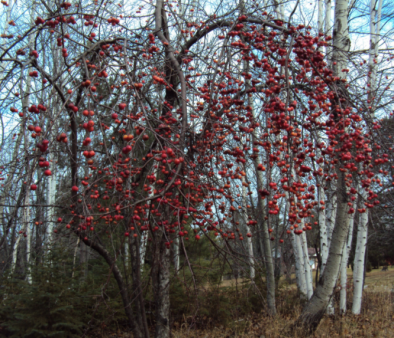
First of all, the tree should be approachable. If the lower branches are dragging on the ground and form a fence around the tree then they should be cut off or thinned. What good is an apple tree if you can’t even get close to it? There should be an established route up into the tree for picking and pruning and for children and other tree climbers. Secondly, all dead wood should be removed. Then its time to step back and take a good look at the tree and think about balance. Is the tree leaning? Could the center of gravity be brought back over the trunk by pruning out a few limbs? This is a crucially important step for young trees. Keep the tree upright by pruning.
Apple trees are generally trained to a central leader when they are young. Then when they are 8 or 10 feet tall the leader is allowed to whorl and the tree is encouraged to grow horizontally rather than vertically, broad rather than tall. If you have an older apple tree these decisions have already been made for you and, for better or worse, the framework of the tree has already been established. Regardless of how old the tree is there are some rules of thumb for pruning. Prune out any new growth that is either vertical or heading back in towards the middle of the tree. Direct all new growth out horizontally. Let the lowest branches extend out the furthest, with each succeeding layer of branches stepped in so that they aren’t shading the lower branches. Prune out any crisscrossing branches. Make sure all branches have space around them, that they are not competing for sun and air with their neighbors. The effect you want is a tree which is mostly clear in the middle with an even density of foliage towards the outside perimeter. The old adage goes that an apple tree is well pruned when a bird can fly through it. A healthy mature tree can be pruned quite heavily with no ill effects although you should attempt to remove no more than a third of the foliage in any given year.
No discussion of pruning would be complete without mentioning the importance of leaving the branch collar intact when removing a branch. The branch collar is the slight flare where a branch meets the trunk. Make your cut, not flush, but slightly outboard of the trunk and the wound can heal completely over in one season. Painting the wound with tree paint is an archaic practice that is no longer recommended.
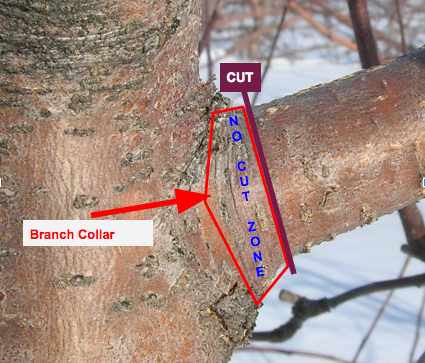
When is the best time to prune? Prune when the tree is still dormant but the most severe cold weather has passed. Late February to early April is ideal.
